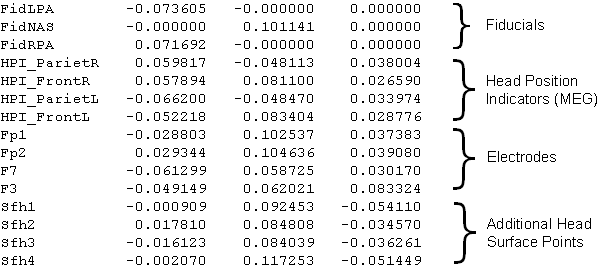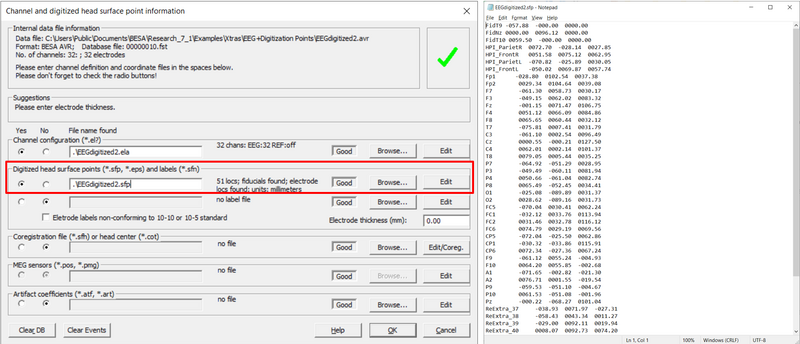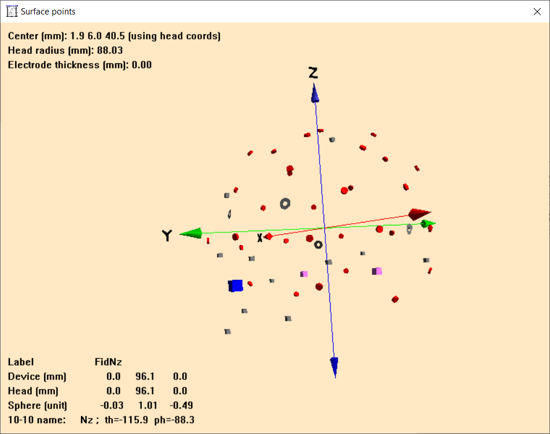Difference between revisions of "Importing Digitized Points Measured by Polhemus Fastrak"
m |
m |
||
| Line 5: | Line 5: | ||
}} | }} | ||
| − | When head surface points and/or EEG sensor locations are measured using [https://polhemus.com/scanning-digitizing/digitizing-products/ Polhemus Fastrak] device together with [https://cortechsolutions.com/products/emse | + | When head surface points and/or EEG sensor locations are measured using [https://polhemus.com/scanning-digitizing/digitizing-products/ Polhemus Fastrak] device together with [https://cortechsolutions.com/products/emse/locator/ '''Locator'''] software or [https://neuroimage.usc.edu/brainstorm/Tutorials/TutDigitize '''Digitize GUI of Brainstorm'''], the digitized points can be exported to a file format compatible with BESA Research (e.g. surface point coordinate file, [http://wiki.besa.de/index.php?title=Working_With_Additional_Files#sfp_.28surface_point_coordinate.29_file *.sfp]). |
On the other hand, if you are using '''PiMgr''' software (Polhemus tracker management application), you need to reorganize the digitized surface points to fit the file format BESA Research requires. For example, a .sfp file should be prepared as the screenshot below using labels and cartesian coordinates (x, y, z) values. You can find more detailed information on how to reorganize digitized surface points for BESA Research in the following wiki article: [http://wiki.besa.de/index.php?title=Electrodes_and_Surface_Locations#Polhemus_Digitizer_Data Electrodes and Surface Locations | Polhemus Digitizer Data]. | On the other hand, if you are using '''PiMgr''' software (Polhemus tracker management application), you need to reorganize the digitized surface points to fit the file format BESA Research requires. For example, a .sfp file should be prepared as the screenshot below using labels and cartesian coordinates (x, y, z) values. You can find more detailed information on how to reorganize digitized surface points for BESA Research in the following wiki article: [http://wiki.besa.de/index.php?title=Electrodes_and_Surface_Locations#Polhemus_Digitizer_Data Electrodes and Surface Locations | Polhemus Digitizer Data]. | ||
Latest revision as of 16:12, 20 February 2024
| Importing Digitized Points Measured by Polhemus Fastrak | |
| Modules | BESA Research Basic or higher |
| Version | BESA Research 5.2 or higher |
When head surface points and/or EEG sensor locations are measured using Polhemus Fastrak device together with Locator software or Digitize GUI of Brainstorm, the digitized points can be exported to a file format compatible with BESA Research (e.g. surface point coordinate file, *.sfp).
On the other hand, if you are using PiMgr software (Polhemus tracker management application), you need to reorganize the digitized surface points to fit the file format BESA Research requires. For example, a .sfp file should be prepared as the screenshot below using labels and cartesian coordinates (x, y, z) values. You can find more detailed information on how to reorganize digitized surface points for BESA Research in the following wiki article: Electrodes and Surface Locations | Polhemus Digitizer Data.
After the reorganization, digitized surface points can be imported into BESA Research using the Channel and digitized head surface point information dialog (File → Head Surface Points and Sensors → Load Coordinate Files..., keyboard shortcut: CTRL + L). See also the following wiki article: Importing Digitized Coordinates.
The imported digitized surface points can be inspected in a 3D view using the menu File → Head Surface Points and Sensors → View (keyboard shortcut: V).


